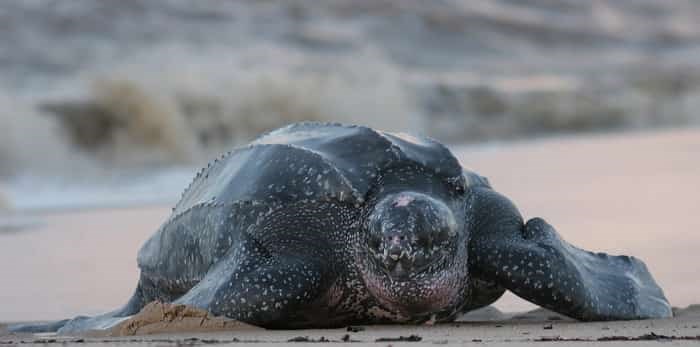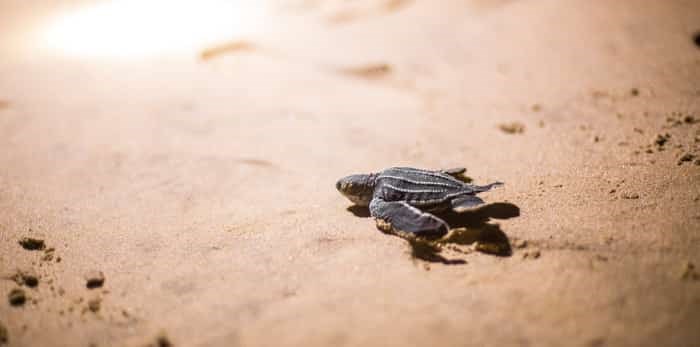 Leatherback sea turtle / Shutterstock
Leatherback sea turtle / Shutterstock
If you see one of these giants in B.C. waters, make sure that you tell everyone about it.
They weigh over 1,000 pounds and are over six feet long, and yet it is rare to spot one on the open ocean. In fact, leatherback sea turtles are the fourth heaviest reptile in the world - the only three heavier reptiles are all types of crocodiles. And while British Columbian waters never entertain crocodilians, leatherbacks visit B.C.'s coast every year to feed on jellyfish.
These ocean-dwellers are spectacular for myriad reasons, but their global populations are dwindling at an alarming pace. As a result, it is now more important than ever that people ascertain the human-induced threats to their habitat and work to minimize the harm that is caused to this critically endangered species.
Vancouver Is Awesome spoke to Lisa Spaven, Marine Mammal Technician, Fisheries and Oceans Canada, who outlined the risks these reptiles face, as well as the remarkable nature of their global journey.
"Leatherbacks are a rare sighting in B.C. - we've only recorded 147 of them since 1931," she explained. "They are difficult to spot from a distance, and they tend to swim in a space that is difficult to observe - they forage for jellyfish in the pelagic zone of the ocean, which is well-below the surface. With that being said, they do have to come up for air, but they aren't as easy to spot as whales, where one can more easily search the horizon for blows."
Spaven added that her department typically sees the leathery giants when they go out looking for whales. However, it is always a welcome surprise when they do spot the sea-faring reptiles.
"Blue whales are also a rare sighting in B.C. waters, and it is interesting that there have been sightings of the large whales on the same day that leatherbacks were spotted," notes Spaven. "We have actually recorded a blue whale sighting in 2006 on the same day that a leatherback was spotted. Only a couple of years later, in 2008, there was a blue whale sighting on the same day that a leatherback was reported."
Blue whales are also an endangered species, but they are also the largest mammal on the face of the earth. As such, spotting a blue whale is typically easier, since they measure in at a jaw-dropping 100-feet-long.
And while leatherbacks are a fraction of the size of blue whales, they still make their way around the globe. The same turtles that feed off the coast of B.C. nest in Indonesia. As such, the Western Pacific Population swims an awe-inspiring 15,000 km from the warm Indo-Pacific waters to the Pacific coast to forage.
 baby leatherback sea turtle on the beach / Shutterstock
baby leatherback sea turtle on the beach / Shutterstock
Leatherbacks lay roughly 100 eggs at a time, but few of the hatchlings will reach adulthood.
"The tiny hatchlings face a number of threats," describes Spaven. "For instance, there are vines on the beaches of Papua New Guinea that grow down the sand and can actually strangle the eggs - kind of like a morning glory. And, even if they do hatch, there are a number of predators that may get them before they make it to the ocean. People are even known to capture the turtles, and their eggs are seen as a delicacy."
Once the turtles make it to the water, however, the struggle is far from over. Not only do they face severe habitat loss, but the ocean is also a flood (pun intended) with garbage. Unlike hardshell turtles, leatherbacks can't move their head back into their shell; they also can't swim backwards. Consequently, the reptiles frequently get caught in plastics and other debris that is scattered throughout the ocean.
And while they possess a unique, prehistoric charm on the outside, the inside of a leatherback's mouth is unexpectedly creepy. Nevertheless, this startlingly scary mouth serves an important purpose for the aquatic critters - it prevents jellyfish from slipping out once they're caught. The spiny projections in their mouths, known as papillae, also help to protect them from the sting of the jellyfish. Sadly, leatherbacks also mistake plastics for jellyfish, and many die as a result.
https://www.instagram.com/p/BuArlskHK7A/
How can you help?
- avoid the use of plastics, especially plastic bags
- never release balloons into the air
- report sightings
- help raise awareness
Only five per cent of the Western Pacific Population of leatherbacks is left. Raising awareness of #leatherbacksinbc is very valuable to to the research being done to reduce threats to Leatherbacks. Please report sightings off the coast of BC to 1-866-I-SAW-ONE and visit here for further information.
https://www.instagram.com/p/BpQ8JjSFMxC/
https://www.instagram.com/p/BuD1HYUA9Ca/


